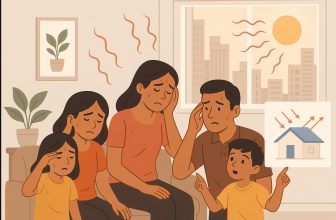Every day, millions of homes in India run on unsafe wiring without realizing it. From overloaded plug points to uncovered switchboards, these hidden mistakes aren’t just technical, they’re dangerous. Small habits like using the wrong plug, skipping earthing, or fixing wires with tape can quietly build up into serious fire or shock risks.
And it’s not limited to old houses. Even modern flats with new appliances often make the same indoor mistakes, putting children, seniors, and daily routines at risk.
This list highlights 17 indoor electrical mistakes that still happen far too often. Understanding them can help you avoid fire hazards, electric shocks, and costly appliance damage, without needing to redo your entire wiring system.
1. Ignoring or Not Testing Earthing Connections
Most people assume their house has proper earthing, but very few actually test it. Without working earthing, metal-bodied appliances like geysers, fridges, or washing machines can give shocks. Earthing also wears down over time, especially during monsoons or soil movement.
- Use a socket tester (available for under ₹500) to confirm proper earthing, especially in the kitchen and bathroom.
2. Using 2-Pin Plugs for Heavy Appliances
Devices like induction cooktops, water heaters, or desktop computers should always use 3-pin plugs. Yet many homes continue to plug them into 2-pin sockets using converters or loose adapters. This removes grounding protection entirely.
Why it’s risky: A short circuit or internal leak can make the appliance surface live, causing serious injury.
3. Plugging 15A Devices into 6A Sockets
Many people use the same socket for phone chargers, mixers, and even geysers. But 6A sockets are not built to handle high-wattage appliances. The socket may heat up, warp, or spark during extended use.
Solution: Check the amp rating printed on sockets. Use separate 15A points for heaters, geysers, and ACs.
4. Overloading Extension Boards
Connecting multiple gadgets, TV, router, laptop, phone charger, to a single extension board is very common. Adding another board to that setup only makes things worse. Overloading can lead to fire hazards, especially if boards are behind beds or curtains.
Fix: Use only one extension per wall socket. Spread the load and unplug high-wattage devices when not in use.
5. Not Using RCD or ELCB Breakers
Most homes still rely on MCBs that trip only on overload. RCDs (residual current devices) disconnect the power if there’s even a small current leak, like what happens when water touches a live part. They’re especially important in bathrooms and kitchens.
- An RCD can cut power within 30 milliseconds, fast enough to prevent serious shocks.
6. Leaving Open Wires or Switchboards Uncovered
Loose plates, open junctions, and dangling wires are common in older homes and rentals. These expose live parts and invite accidents involving children, pets, or cleaning staff.
Prevention: Get broken switchboards replaced with modular units. Cover all open boxes, even if temporary, with proper insulating covers.
7. Ignoring Warning Signs Like Flickering or Crackling
Flickering lights, switches that spark, or warm plates are all signs of deeper wiring issues. These often point to loose terminals or damaged insulation inside the walls.
- Don’t wait for a fuse to blow. Call a licensed electrician to inspect and replace affected circuits
8. Hiding Wires Under Carpets or Rugs
Running wires under carpets seems like a neat solution, but it traps heat, causes friction, and weakens insulation over time. Damage is often invisible until the wire fails.
Better option:
Use surface trunking or cable organizers along the wall. Keep wires visible and away from foot traffic.
9. Sharing Circuits Between Heavy Appliances
In many homes, devices like washing machines and microwave ovens run on general-purpose sockets. These may not be wired for high current, especially if shared with lights or fans.
- Risk: It can cause dimming, tripping, or even melting of wiring if demand spikes.
- Always check if the line has a dedicated breaker for large appliances.
10. DIY Electrical Repairs With Tape and Loose Joints
Jugaad fixes with black tape, twisted wires, or cheap joint boxes are extremely common in Indian households. These quick fixes might seem to work, but they degrade fast, especially in humid areas.
Safer approach: Use screw connectors or terminal blocks. Avoid electrical tape as the only layer of insulation.
11. Operating Switches With Wet Hands
This is especially risky in kitchens and bathrooms. Even small moisture on fingers can cause minor shocks. Over time, switches themselves can develop internal damage due to corrosion.
Fix: Dry hands before use. Install water-resistant switches near wet zones.
12. Mounting Inverter Batteries in Closed Rooms
Lead-acid batteries release hydrogen during charging. In closed areas like store rooms, this can accumulate and ignite with a small spark.
Better setup: Install inverters near windows or grills. Ensure the room is well-ventilated.
13. Not Using Surge Protection for Electronics
Most people plug in smart TVs, fridges, routers, and laptops directly into the wall. Power cuts and return surges are common in India and can damage sensitive circuits.
- Plug electronics into certified surge guards. Use separate ones for entertainment and kitchen zones
14. Charging Phones on Soft or Flammable Surfaces
Many people leave phones charging on beds, under pillows, or on couches. If the charger malfunctions or the phone heats up, fabric can catch fire.
Safe charging habits: Charge on hard, flat surfaces like a table. Don’t leave chargers running overnight on bedding.
15. Ignoring Burn Marks on Plugs or Boards
If you see black marks near a plug, it means there’s arcing, when electricity jumps through air due to a loose connection. This can melt plastic or cause hidden sparks.
- Stop using that socket. Replace both plug and socket as soon as possible.
16. Keeping Sockets Accessible to Crawling Children
Most Indian homes don’t use socket guards. Floor-level outlets are dangerous for toddlers, who might insert keys, pens, or fingers.
Childproofing tip: Use socket covers and furniture placement to block access. Choose modular sockets with inbuilt shutters for future upgrades.
17. Not Scheduling Electrical Health Checks
Wiring ages, just like appliances do. After 5-7 years, terminals loosen, insulation cracks, and joints corrode, even in newer buildings.
Routine check: Hire an electrician every 5 years to inspect breakers, distribution boxes, and high-load lines. Prevention costs much less than repair.
How to Make Your Home Safer Without Rewiring
You don’t need to overhaul your entire electrical system to reduce risks. Start with:
- Replacing broken sockets
- Installing an RCD unit
- Using surge guards
- Checking earthing with a basic tester
- Covering open boards and sockets
Each step lowers the chance of shock, fire, or appliance failure, especially for seniors and children at home.
Summary – Stop Unsafe Indoor Electrical Practices
Most electrical dangers in Indian homes don’t come from rare events. They come from daily habits, plugging too many devices into one socket, ignoring warning signs, or assuming a cheap fix will last forever.
By correcting these 17 mistakes, you reduce long-term risk, improve appliance life, and make your home safer for every person who lives there.





